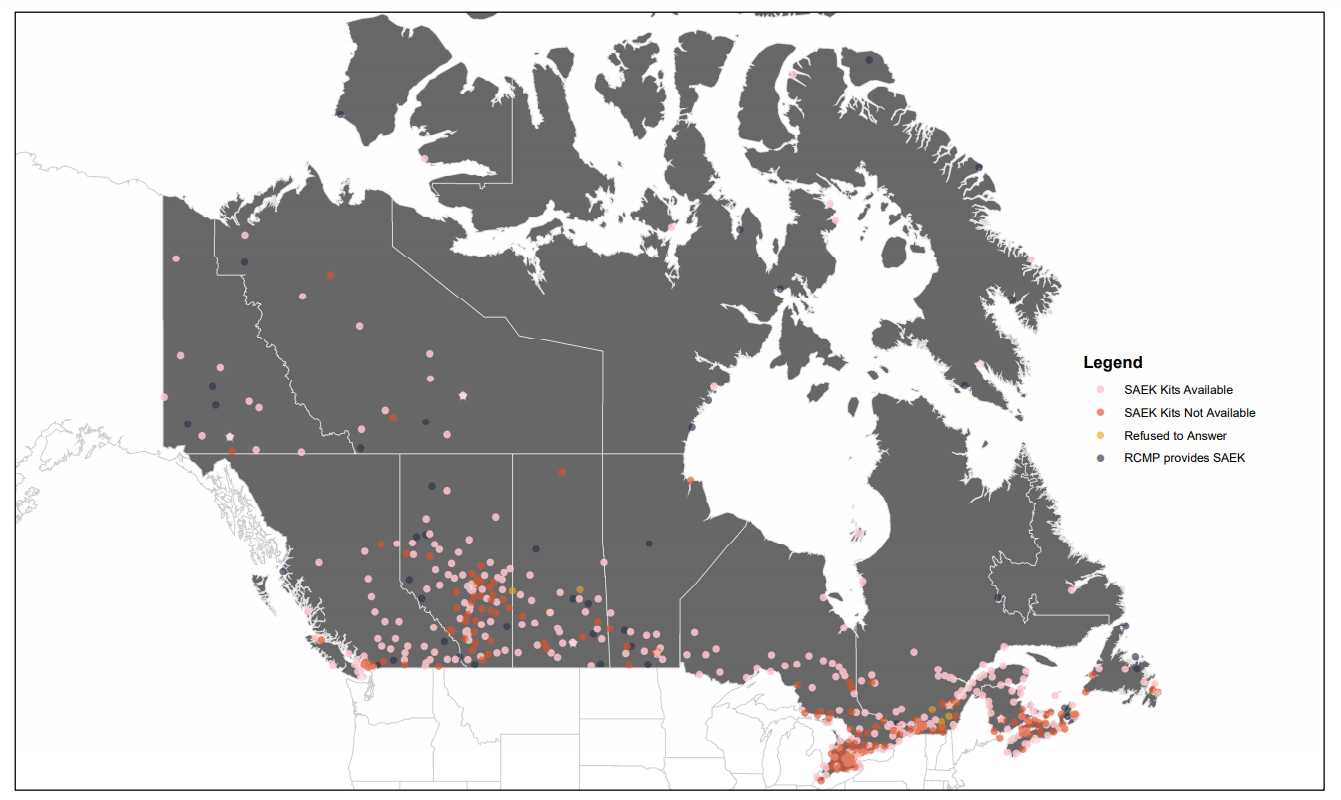Silenced: Canada's Sexual Assault Evidence Kit Accessibility Crisis
She Matters led a 12-month study into sexual assault evidence kit accessibility in Canada. This volunteer led study gathered data from over 700 hospitals and health centres. The findings exposed deep violations of access to justice for survivors across the country.

Trigger Warning: The following report may be disturbing to some readers. Please exercise caution when reviewing the information shared if you identify as a survivor of sexual assault.
She Matters acknowledges that this report was written on the traditional territory of the Atikameksheng Anishnawbek. Data collection took place on and across many Indigenous traditional territories and nations.
She Matters Silenced Report provides a comprehensive overview of first-hand responses received by survivors and allies when requesting information pertaining to Sexual Assault Evidence Kit, also referred to as a “SAEK” and more commonly known as a “rape kit,” accessibility at Canadian emergency room departments and health centres.
581 hospitals and health centres were directly reached throughout the course of the study.
National Findings
The study concluded that 41% of Canadian Hospitals did not have kits, relied on the RCMP to bring kits or refused to disclose whether their facility had kits.
Alberta - 45%
BC - 30%
Saskatchewan - 35%
Manitoba - 52%
NWT - 38%
Yukon - 29%
Nunavut - 47%
Quebec - 43%
Ontario - 39%
NFL - 53%
Nova Scotia - 51%
PEI - 40%
New Brunswick - 37%

Forensic Evidence Collection Map
Are you a survivor in need of accessing forensic evidence collection following` a sexual assault?
Our Forensic Evidence Collection map highlights all hospitals and health centres which responded 'yes' to having SAEKs available to survivors at their health centre or hospital.
Disclaimer: The following map contains information collected in 2021 regarding hospitals and health centers. We strive to provide accurate and up-to-date information, but please note that the information shared is subject to change. We cannot guarantee the availability of Sexual Assault Evidence Kits (SAEKs) at the hospitals and health centers listed on the map.If you are a medical professional at a hospital or health center that offers SAEK examinations and is not listed on our map, we encourage you to contact our team at [email protected]. Please provide the necessary details about your center, and we will be glad to add it to our directory.
We recommend consulting with a qualified healthcare provider or contacting the respective hospital or health center directly for the most accurate and up-to-date information regarding SAEK services. By using the map, you acknowledge and agree that She Matters and its team are not liable for any errors, omissions, or changes in the information provided on the map. Please be aware that the availability of SAEKs may be subject to various factors, including but not limited to the policies, resources, and capabilities of each hospital or health center. The inclusion or exclusion of any hospital or health center on the map does not reflect their endorsement or lack thereof for SAEK services. Your use of the map signifies your acceptance and understanding of this disclaimer. If you do not agree with any part of this disclaimer, we advise to refrain from using the map. If you have any questions or concerns about this disclaimer or the information provided on the map, please contact our team at [email protected].
Store Locator Software Loading...
Key Findings
The following key trends were observed.
- 41% of hospitals and health centres reached by She Matters throughout the course of the Sexual Assault Kit Accessibility study stated they did not have sexual assault kits available to survivors.
- Many hospitals do not have nurses or physicians trained in conducting a SAEK examination. Further, training is required to gather evidence without further re-traumatizing the survivor.
- Hospitals lack the tools to support survivors, including a lack of proper storage facilities for sexual assault kits (fridges that lock to secure evidence).
- Many hospitals and emergency rooms could not answer with certainty if sexual assault kits and services were available for survivors.
- Many hospitals referred the caller to seek services at a specific hospital, only for the caller to later determine that the referred hospital also did not provide SAEK services. Thus demonstrating an institutional disconnect regarding eligibility of services.
- Many hospitals expressed frustration in being the only hospital in a region to provide SAEK services and a desire for all hospitals to conduct kits to lessen the stress on certain facilities and to better support survivors.
- It is not mandatory in nursing and medical schools to learn sexual assault evidence collection. Many colleges charge a fee beyond traditional tuition for nursing students who want to take a SANE course on weekends.
- There is a divide in urban/rural health-care access, with far better accessibility for city dwellers.
- Sensitivity training should be required for all hospital staff, including triage staff and phone operators, particularly in hospitals that responded negatively to sexual assault-related inquiries.
- Hospitals and police departments do not have national databases listing hospitals and health-care centres with SAEKs available to survivors.
Defining Sexual Assault
Sexual Assault is defined as “an assault of a sexual nature that violates the sexual integrity of the victim.” The Supreme Court of Canada held that the act of sexual assault does not depend “solely on contact with any specific part of the human anatomy but rather the action of a sexual nature that violates the sexual integrity of the victim.”
Women and girls between the ages of 15 - 24 years old represent the highest affected population affected by sexual assault.
It is estimated that 11 million Canadians have been physically or sexually assaulted since the age of 15. Despite the staggering rates of sexual violence in Canada, only 3% of sexual assault cases lead to a conviction.

Classifications of Sexual Assault
The SAEK is imperative in sentencing for cases of sexual assault. Previously labeled as rape within the Canadian Criminal Code, sexual assault has now been broken down into three categories of sexual assault classifications, with a fourth classification consisting of “other sexual violations.” Specifically, sexual assault can involve a range of unwanted acts including kissing, penetration, rape, molestation, attempted rape, and unwanted hugging or groping.
The three classifications of sexual assault are as follows:
- Level 1 sexual assault is an assault committed in a sexual nature, such as the survivor is violated. Level 1 includes minor physical injury or no bodily injury to the survivor.
- Level 2 sexual assault involves sexual assault with a weapon, threats, or causing bodily harm.
- Level 3 sexual assault results in wounding, disfiguring, maiming, or endangering the victim’s life.
Other sexual violations include sexual interferences, an invitation to sexual touching, sexual exploitation, incest, luring a child via computer, anal intercourse, corrupting children, bestiality, and voyeurism. Based on life-threatening notions or injury, a sexual assault will be classified and sentenced based on the threat to the survivors’ life in addition to the sexual assault or sexual violations that took place.
What is a Sexual Assault Evidence Kit?
A Sexual Assault Evidence Kit (SAEK) collects forensic evidence following a sexual assault. SAEKs include a series of documents, swabs, evidence bags, and photography tools to be utilized by a sexual assault nurse examiner or assigned medical professional during the sexual assault examination process. The kit includes forms, checklists, and documentation pages, which are utilized to record a survivor’s first-hand account of what they experienced.

Why is Access to a Sexual Assault Evidence Kit Important?
According to Statistics Canada, sexual assault is the least likely violent crime to be reported to the police. Statistics Canada estimates that approximately 91% of sexual assaults are never reported.
A survivor of sexual violence can seek justice in several ways; the most common way is through the judicial process, including having the perpetrator investigated, arrested, charged, and eventually sentenced for their crime. A SAEK collects vital forensic evidence that is utilized at trial to assist in achieving a conviction.
Where a survivor lives significantly impacts their ability to access a SAEK. At present, there is no legislation requiring hospitals to carry SAEKs.
The absence of provincial and federal legislation results in substantial discrepancies between hospitals and health-care centres regarding the availability of kits, the treatment of survivors seeking access to SAEKs, and the reliability of the preserved evidence collected to stand up in court.
The Victim Bill of Rights
The Victims Bill of Rights is an act that protects the rights of victims of crime in Canada. On April 23, 2015, the Victims Bill of Rights Act received Royal Assent. The provisions and amendments included in the Victims Bill of Rights Act include creating the Canadian Victims Bill of Rights, and amendments to the Corrections and Conditional Release Act (CCRA), Criminal Code, Canada Evidence, and Employment Insurance Act.
The Canadian Victims Bill of Rights provides the following right to survivors of sexual assault: the right to information, the right to protection, the right to participation, and the right to restitution.
The right to information constitutes that the survivor has the right to be notified of the status and outcome of their investigation, and the location of court proceedings, and to be provided with information about available community services and supports.
The right to protection constitutes that survivors are afforded protection services should their security and privacy be considered a risk during investigations.
The right to participation conveys that survivors have the right to participate in legal proceedings where decisions are being made by authorities that affect their rights under the act, and to have their views considered.
The right to restitution constitutes that survivors can seek civil actions for any loss of wages or emotional damages incurred due to the alleged sexual assault. Additionally, survivors have the right to remedy should they feel their rights have been breached by a federal department, agency, or body to which they wish to file a complaint.
Provincial and Territorial Results
Findings revealed that 41% of hospitals and health centres reached did not have sexual assault evidence kits available, required RCMP to bring, or refused to answer.
The image pictured below captures the data collected

Are Sexual Assault Evidence Kits Available in
Your Province?
Stay Updated
Sign up for the She Matters newsletter to stay up to date on upcoming campaigns.
Change begins with us.
Read the Silenced: Canada's Sexual Assault Evidence Kit Accessibility report now.
Read Now.Call to Action
Join She Matters in signing the Rape Kits In Canada Now petition founded by survivor Gabrielle Doyon Hanson of Montreal, Quebec, calling for action by the Federal Government of Canada to ensure sexual assault evidence kit accessibility in Canada.

